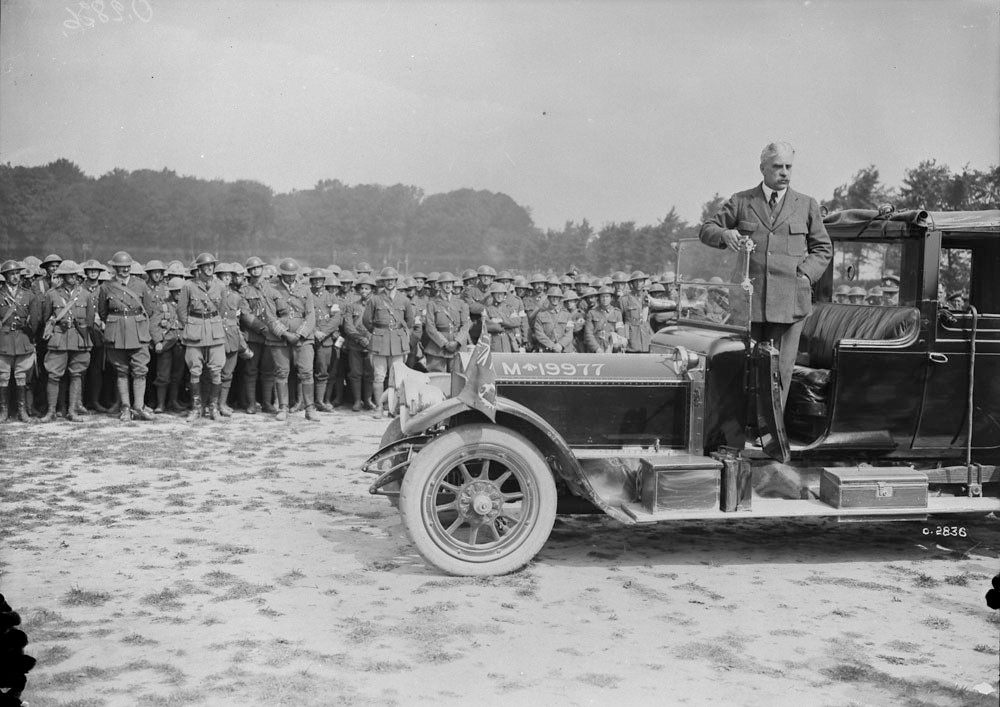Sir Robert Borden
1854-1937
Borden was prime minister between 1911 and 1920 and successfully garnered international recognition of Canada as an autonomous dominion. He formed a Union Government to lead Canada during the final difficult years of the First World War and he visited the war fronts several times. Ill health forced him to leave politics in 1920.
For 30 years (1907-1937), Borden lived at 201 Wurtemburg St. just north of Rideau St. in a house called “Glensmere” (His wife Laura lived there for another three years). Borden had already bought a lot on Marlborough Ave. on which to build but was persuaded by his wife to buy Glensmere, which backed onto the Rideau River, instead. Although a beautiful house (its architect F.J. Alexander had also designed the interior of the Library of Parliament), it was badly insulated and two radiators froze the first two years the Bordens lived there.
Borden also noted later that the location had a number of disadvantages at the time: the street was in terrible condition and the land at the back of the property was being eroded by the river; Macdonald Gardens across the street did not exist yet and was the former site of the Sandy Hill cemeteries.[1] The land remained unkempt, attracting shady characters at night until it was turned into a park in 1912. In 1942, Glensmere became the embassy of the Republic of China. It was demolished in 1970 to be replaced by the Watergate apartment building.

A reserved man, Borden was not a natural politician and he came to politics late (at age 42) after being recruited by Charles Tupper at a dinner at the latter’s Ottawa home. He assumed the leadership of the Conservative Party reluctantly in 1901 and although he made his acceptance conditional on being in the post no longer than one year, he stayed on to become prime minister in 1911 and lead the country until his resignation in 1920. Borden disliked pomp and ceremony and never felt fully comfortable with the knighthood he had received in 1913. Before his death, he told his nephew “none of this ‘Sir’ stuff at the cemetery, just plain Robert Laird Borden.” (Borden, 1971)
Borden was a voracious reader and lover of poetry. Gifted with an unusual memory, he could recite whole poems verbatim. He wrote in 1932 — five years before he died — that “books, some business avocation, my wild garden, the birds and the flowers, a little golf, and a great deal of life in the open — these together make up the fullness of my days.” The books were often by Dickens, Scott and Shakespeare. The business “avocation” was his presidency of the Barclay’s Bank of Canada and the Crown Life Insurance Co.
Borden took great pride in his garden and over the years he and his wife established a number of rockeries, planted trees and paved paths on the slope leading to the river. There, he liked to observe birds: he counted 25 different species, most nesting in his garden. During the summer, he sometimes slept out doors the better to experience nature.
In 1934, Borden was asked to speak at the opening of the new public library on Rideau St. He recalled with some mirth in his diary that the then-mayor of Ottawa extolled the value of literature by praising Homer for having acquainted the world with Alexander the Great.
Borden was a parishioner of All Saints Anglican Church (Chapel and Laurier) for 37 years and a memorial window in the church is dedicated to him. A thousand Great War veterans formed a guard of honour along Laurier Ave. while many thousands of mourners lined the procession route between Glensmere and All Saints for his state funeral in 1937. The cortège was led by a troop of 33 RCMP officers under the command of Superintendent J.M. Tupper, son of Borden’s former law partner and grand-son of Prime Minister Sir Charles Tupper. Borden is buried in Beechwood Cemetery.
[1] The cemeteries opened in about 1845 and closed to burials in 1872 at about the time Beechwood and Notre Dame cemeteries opened further out of town. The cemeteries had been divided into four lots for Anglicans, Presbyterians, Wesleyan Methodists and Catholics.
